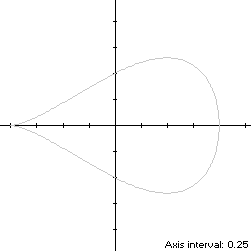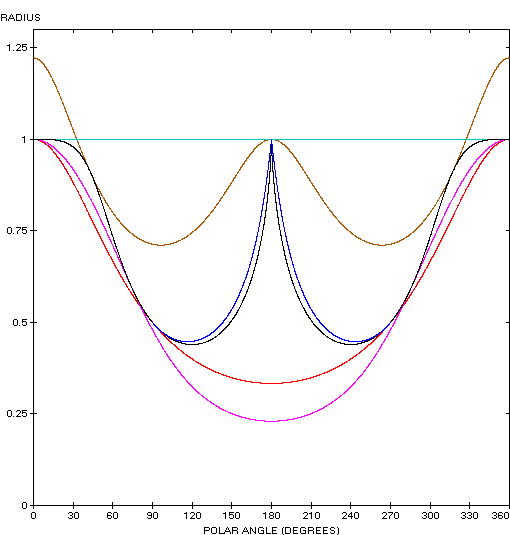Balmoral Software

Balmoral Software

x(t) = -cos(t)The curve follows a clockwise path as t increases, starting from the left cusp aty(t) = sin(t)sin2(t/2), 0 ≤ t < 2π
 when
when

x'(t) = sin(t)so by (L1), the perimeter of the teardrop curve isy'(t) = [cos(t) - cos(2t)]/2
and its area is
By (C1), its centroid abscissa is
(Note: WolframAlpha has reversed the coefficients.)
x''(t) = sin(t)so by (X1), the teardrop curvature changes sign at (-1,0) sincey''(t) = sin(2t) - sin(t)/2,
sin(t)[sin(2t) - sin(t)/2] = cos(t)[cos(t) - cos(2t)]/2is satisfied for t = 0. Equation (X2) is evaluated with respect to the point (-1,0) as
which has a solution in the upper half-plane at t = π/2, so the convex hull line segments extend between the points (-1,0) and
 By
(L1), the perimeter of the convex hull is:
By
(L1), the perimeter of the convex hull is:
which is less than 1% shorter than that of the teardrop curve.
The line segments of the convex hull create an isosceles triangle with its base on the y-axis, having area 1/2. The centroid abscissa of this triangle is the average of its vertex abscissas, or -1/3. By (A1), the remainder of the convex hull has area
By (C1), the associated centroid abscissa is
The convex hull component metrics can be summarized as follows:
The area of the convex hull is 1.618732, about 3% larger than that of the teardrop curve. The centroid abscissa of the convex hull is the weighted average
Region Area Centroid abscissa Product Triangle 1/2 -1/3 -1/6 Remainder A = 1/3 + π/4 (1/3 + π/16)/A 1/3 + π/16 Total 5/6 + π/4 1/6 + π/16
which is 1/(20 + 6π) to the left of the centroid of the teardrop curve itself, exactly the same distance as the corresponding value for the piriform curve.
 of the
teardrop curve does not define its inradius since the corresponding abscissa 1/2
is too close to the right edge (1,0), so its incircle is constrained by the
right edge. Using z = 1 in Lemma C, we
have
of the
teardrop curve does not define its inradius since the corresponding abscissa 1/2
is too close to the right edge (1,0), so its incircle is constrained by the
right edge. Using z = 1 in Lemma C, we
have
and R = |c - z| =
 . For
verification, we have
. For
verification, we have
d/dt [x(t) - z]y(t) = d/dt -sin3(t)/2has a zero at t* = π/2. The corresponding coordinates are
x* = 0which is the endpoint of a convex hull line segment. We then havey* = 1/2,
For verification,
d/dt [x(t) - z]y(t) = d/dt 2sin4(t/2)sin(t)has a zero at t* = Arccos(-2/3). The corresponding coordinates are
from which we have
For verification,
Figure Parameters Perimeter Area Centroid Incircle R = 3.864786 1.188615 (0.384900,0) Inellipse 3.913233 1.209200 (0.333333,0) Teardrop curve 5.13734 1.570796 (0.25,0) Convex hull 5.127128 1.618732 (0.224260,0) Circumellipse 5.810712 2.503567 (1.111111,0) Circumcircle R = 1 6.283185 3.141593


The teardrop curve (red) is a member of a group of similarly-shaped figures described on these pages, including (inside to outside) the Tschirnhausen cubic, the right strophoid, the Trisectrix of Maclaurin and the piriform curve:
x1(t) = x(t) + 1 = 1 - cos(t)These coordinate functions cannot be directly compared with the corresponding ones for the piriform curve since the rates of travel along the path T (if t is considered a time variable) vary between the two curves. However, the path itself is the same for both curves since x1(t), y1(t) satisfy the cartesian form of the piriform curve:y1(t) = 2y(t) = 2sin(t)sin2(t/2)
y2 = x3(2 - x)
Copyright © 2021 Balmoral Software (http://www.balmoralsoftware.com). All rights reserved.